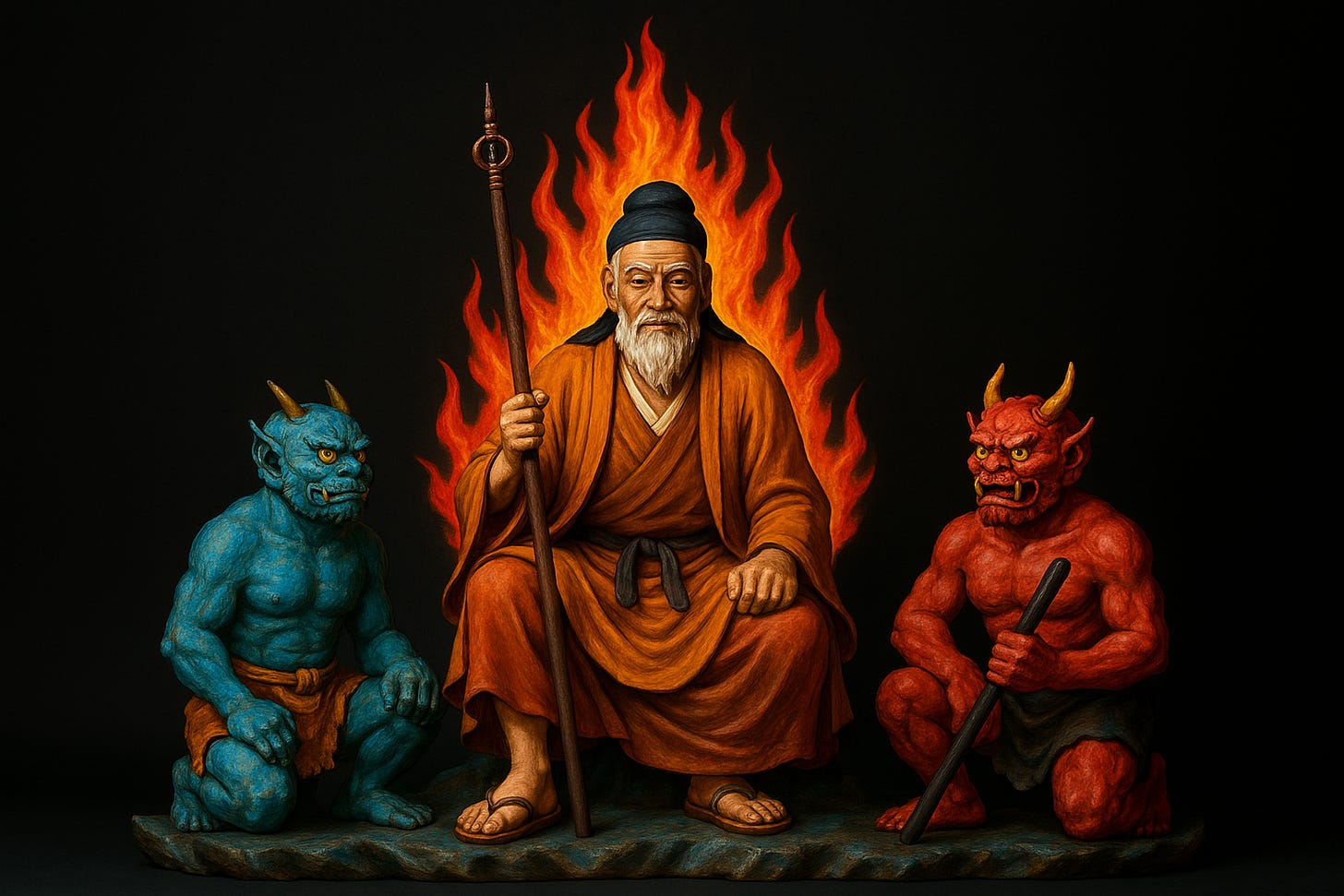En no Ozunu and Ancient Mystical Mountain Tradition
Legendary Founder of Shugendo Asceticism
Japan, with its limited landmass surrounded by steep mountain ranges, has long seen vibrant practices of mountain worship. However, surprisingly, the ancient Jomon and Yayoi people did not engage in mountain worship; this movement appeared much later in Japanese history. Central to this shift was En no Ozunu (役小角), also known as En no Gyoja (役行者).
En no Ozunu is considered the ancestral figure of Japan’s ancient mountain ascetics, eventually giving rise to a mysterious group known as the Yamabushi (山伏), who would quietly influence society for over a thousand years. Due to his profound impact, En no Ozunu’s life became interwoven with historical facts and legends, making him one of the most revered and enigmatic figures in Japanese culture.
En no Ozunu is believed to have been born around 634 CE in present-day Gose City, Nara Prefecture, though there are no definitive historical records of his birth. According to ancient folklore compiled in Japan’s earliest anthology of tales, the Nihon Ryoiki (日本霊異記) from the early Heian period, En no Ozunu was a member of the influential Kamo clan (賀茂氏). This clan later became notable for producing Kamo no Tadayuki (賀茂忠行), ancestor and master of the famed onmyoji (陰陽師) Abe no Seimei (安倍晴明, 921–1005), known for his esoteric practices called Onmyodo (陰陽道). Thus, at the clan’s roots lay deeply guarded magical traditions.
From childhood, En no Ozunu displayed remarkable intelligence and a profound interest in Buddhism. It is said he taught himself Buddhist scriptures and diligently pursued ascetic practices. Even as a boy, he dreamt vividly of riding “five-colored clouds” to visit palaces inhabited by immortals, deeply yearning for mystical experiences. Such inherent spiritual tendencies and surroundings shaped the core of his later beliefs and rigorous asceticism. Rather than becoming a formal monk, En no Ozunu remained a lay Buddhist practitioner, or Ubasoku (優婆塞), retreating into the mountains of his homeland, notably Mount Katsuragi, where he began intensive mountain ascetic training. Legend says he lived deep in caves on Mount Katsuragi (葛城山) and Mount Omine (大峰山) for over 30 years, surviving solely on pine needles and wild herbs. During this rigorous ascetic life, En no Ozunu independently mastered powerful esoteric rituals derived from the Mahamayuri Vidyarajni Sutra (孔雀明王経, Kujaku Myo-o Kyo), gaining remarkable supernatural abilities and gradually ascending into a role resembling a political fixer behind the scenes.
Additionally, En no Ozunu reportedly mastered a skill akin to “flying techniques,” allowing him to soar freely through the sky and ride upon the legendary five-colored clouds. Folktales further recount his ability to summon and control fierce spirits and demons (鬼神, kishin), compelling these supernatural beings to perform menial tasks such as fetching water and gathering firewood. Stories tell of how any disobedient spirits were restrained through magical incantations, spreading his reputation widely throughout Japan.
Despite—or perhaps due to—his godlike mystical abilities, rumors began circulating that En no Ozunu intended to overthrow the Imperial Court. Consequently, Emperor Monmu (文武天皇, r. 697–707) accused the 69-year-old En no Ozunu of sedition through magical practices and exiled him to the remote island of Izu Oshima in May 699. This incident is documented in the Shoku Nihongi (続日本紀), completed in 797. Intriguingly, it is also said that during his exile, En no Ozunu behaved calmly during the day but secretly flew over the ocean at night to continue ascetic practices atop Mount Fuji, making him historically the first person to climb this iconic mountain.
In 701, the Imperial Court reversed his exile through an imperial pardon, attempting instead to integrate En no Ozunu formally into political influence. However, while traveling back from Izu Oshima to Nara, he suddenly soared into the sky and vanished completely. One legend suggests he flew directly to China, where he joined Chinese immortals (仙人) and lived among them. After this event, En no Ozunu disappeared entirely from public records, and while his official death year is often given as 701, historical details remain uncertain. This mysterious disappearance raises questions: Where did such a powerful figure truly go?
For centuries afterward, Japanese people maintained that En no Ozunu attained immortality while alive, perpetuating his legend as an immortal mountain hermit. Inspired by En no Ozunu, monks increasingly abandoned temple life to seek isolation in mountains, adopting unique ascetic practices and supernatural pursuits. This marked the beginning of the Yamabushi tradition and subsequently led to a significant religious movement known as Shugendo (修験道).
En no Ozunu ingeniously blended Indian esoteric Buddhism, Chinese Taoist teachings, and indigenous Japanese mountain spirit beliefs, forming a profound and unique philosophy. Today, his mysterious legacy continues through legends preserved across Japan, forever fascinating and puzzling those who encounter them.





